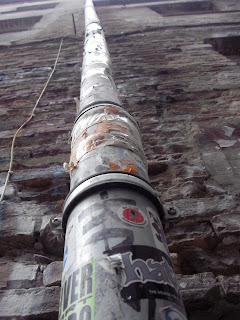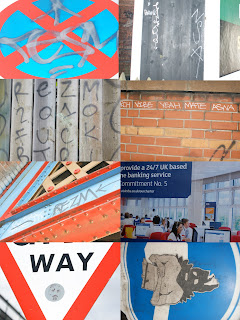Berlin's famous flea market.
Even in -7 degrees celsius we ventured out with the thought of catching some unmissable nicknacks at next to nothing prices. Yes, you could get 'stuff', - and when I say 'stuff' I am referring to worn out bolts and nuts, old typewriter keys (at 2 euros each!), various holey smelly jumpers (at around 35 euros), skinned ferrets (at..I don't know I didn't dare to ask)... the list goes on.
Apart from the fact alot of the 'stuff' was extortionate, dirty and the most random unneeded tat you could ever want, they make rather nice images.
Thursday, 24 February 2011
Tuesday, 22 February 2011
Other alternative art in the streets of Berlin
Following my blog on street art I found in Paris, focusing on Space Invador, I have been scouting the streets of Berlin for the past few days hawk-eyeing various cool stenciling, spray painting, squat workings and murals decorating the walls, ground, objects on the street, squats, and not forgetting works on the remaining Berlin Wall.
These are photographs I took on the Alternative Tour of Berlin, where we were taken around the Mitte area and to the Berlin Wall and East Side Gallery. Many of them are from squats and small streets around what was once the poorer side of Berlin, which has now mostly been rejuvenated (whether people like it or not).
The piece above was actually sponsored by Nike as advertising outside one of the only remaining artist squats in Berlin.
These are all examples of repeated artists work throughout the Mitte area of Berlin. In 2 days it is easy to miss alot and because it is illegal, some of the pieces have been destroyed or covered over. Frequently however these works are ignored as when they are painted over, create ugly blocks of colour, alot worse than the artists work.
Banksy's rat has actually been chipped away on this wall and stolen, left only with his name to show what was once there. This is becoming more popular throughout the streets and also in other cities.
The Berlin Wall has some intriguing and fantastic works of street art. Disgusting however it is that a section of the wall was moved along the riverside to allow the O2 Arena to have a space to put up a huge advertising LED screen, such an eyesore and even more disrespectful.
This is what we we told is the Berlin Motto. Not the 'I love Berlin' but underneath, on the body of the person says 'Sexy Berlin'.
Sunday, 13 February 2011
Ville Savoye
A manifesto for modernity.
The Ville Savoye in Poissy, just outside Paris, is an excellent example of avant-garde modernism. Built in 1929 by Le Corbusier, Savoye bluntly combined Corbusier's 5 points of architecture to create a modular, minimal, clean, white and spacious house for the Savoye family's holiday home. Here arrived 'the box in the air'.
1. Pilotis (elavated floor on stilts.)
2. Open plan.
3. Roof garden
4. Ribbon windows
5. Free-floating facade (facades placed in stilts, their positions determined by the views from the inside.)
In many of his works, we can see his 5 points of architecture, and it was argued Corbusier set the rules for a new take on architecture forevermore. He, alongside other International Architects, did what they wanted to create what they wanted. Corbusier wanted light, free space and openplan living, and this is what he did at Savoye.
However this didn't always succeed as it began to leak almost as soon as the Savoyes' moved in. Many complaints were sent to him saying how it was impossible to live their due to the leaking because of the horizontal roofing. During the war the house was occupied by the Germans and neglected so further restoration has occured to bring it back to its beauty, including making slight architectural changes to ensure it is visitable and livable.
The Ville Savoye is beautiful in it's stark simplicity. Walking around and through the building you feel free and peaceful, some could argue the contrary of feeling exposed and anxious due to the huge glass windows and open plan. Corbusier's ideas, although sometimes shunned for these reasons, opened up peoples' eyes to different ways we could live. It began the International Style and influenced artists like Eames, Lloyd Wright and the development of American Architecture of the 'glass box'.
The Post-Consumer. What would you buy?
What we think a Post-consumer might use, do, buy - how they might live their life.
Interesting points were raised in creating this.
Everyone is different, post-consumerist or consumer crazy. You can't say someone will only shop in certain shops.
I'm sure they're are post-consumerists that shop in Harvery Nichols and Oxfam to create a stylish sustainable outfit.
Monday, 7 February 2011
Analysing sites of Forgotten Spaces
With various snippets of film, performance, photography, sketching and use of photoshop merged together to create an emotional response to 3 spaces. This when then projected onto 3 different medium - the first being a section of brick wall symbolising the industrialism of the space an the textures this creates, and also the foundations of the built environment. The second being a textured surface expressing the uncomfortable atmosphere of the alleyway and the third being a sketch drawing the eye to the sky and away from the ground below, where we usually focus. the projection of shoppers and the lights of the shops whizzing past suggest the hustle and bustle of the high street and consumers rushing around, focusing on one thing - spending.
Labels:
Dundee,
forgotten spaces,
texture and space
Sunday, 6 February 2011
Places and Spaces Forgotten
Forgotten spaces. Site analysis filming of three places neglected but intriguing and important for various reasons we often are unaware.
We have a relationship with spaces. Wether this relationship is evident to you as you walk through a place, simply looking to another space where you are heading it is still there. Within each space you feel something. This is not always a good thing.
These spaces are often forgotten spaces, waiting to be stimulated, simulated or inhabited by a person, object, sense, light or emotion. These forgotten spaces are everywhere - the alleyway around the back of your house, the derelict land across the street, the spaces between the lamppost and the wall, a rooftop inhabited by only bird feaces and feathers. These places are all spaces, often spaces in-between other spaces that mean they become unimportant.
Textures of the alleyway |
Grafitti or Street art? |
The most intriging space for me is the building facades above the main high street shops. People wander, minds focused on one thing - buying, and forget everything around. As I filmed the tops of buildings, I was asked by at least six people what was I actually looking at. They had never before appreciated the beauty of the timeless architecture styles above their heads. This place is simply forgotten because of the consumerism around them in the form of lights, advertising and money.
 |
| The 'forgotten' building tops |
These spaces connect with you as you connect with them. But these places could be improved to convey different emotions, provide a different setting, space or experience through stimulation and simulation. These urban spaces in the environment are intriguing through their individuality and the opportunity for postive changes are endless.
Labels:
forgotten spaces,
neglected places,
places in Dundee
Subscribe to:
Comments (Atom)
















































